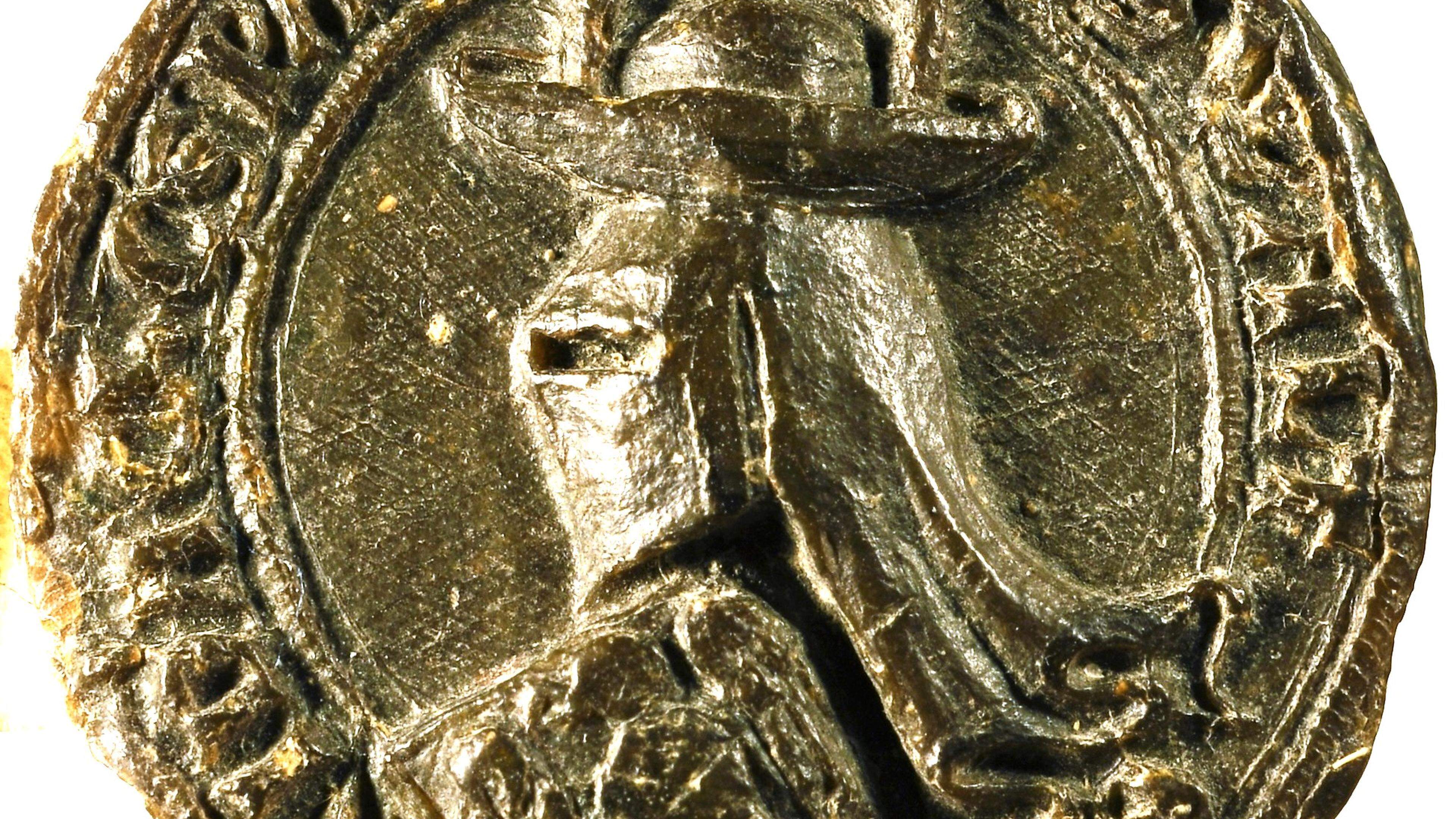The story of Walter von Aspelt: his seal and his coat of arms

The name Walterus de Aspelt seems to appear as a witness in a document from 1136 for the first time.1 For the same year, the eagle in Walter's coat of arms is also mentioned in the document book of Middle Rhine territories.2
The fact that the gentlemen who bore the praised name « von Aspelt » were taken in high social positions and counted at the highest nobility in the country at an early stage from history, according to which Walter von Aspelt as one of the bravest vassal of Heinrich of the blind participated in the conquest of bouillon. Walter also helped fight out all the other feuds of the Count of Luxembourg and he was present in 1182 as the newly confirmed privileges of the Münster Abbey by Heinrich Denblinden, Count of Luxembourg.3
His coat of arms was azure blue with a silver eagle with two spread heads, some claim that he would only have had one head.4
A knight and witness in Luxembourg's history
Another Walter von Aspelt, probably the son of Walter I, is mentioned from 1214 to 1254. In 1214 this Alterus von Aspelt attended the wedding celebrations of the Countess Ermesinde with Walram von Limburg.5 Walter II and his wife Ponzetta were the in -laws of Wilhelm von Preisch/Aspelt, a brother Peters von Aspelt, who was dating Jutta with her daughter.6
In a gift certificate from the Countess Ermesinde of Luxembourg from 1233, in which Walter II of Aspelt appears as a witness, he is called a knight for the first time.7 This was not yet the case with Walter I., because in a certificate from the last years of the government of Count Heinrich von Namur-Luxemburg8around 1182-1190, he is still mentioned as a servant (ministerial) of the count's house.9
The one -headed eagle in the coat of arms of Walter von Aspelt: symbol of strength and bravery.
In a certificate of October 24, 1272, another noble lord Walter appears.10 On September 28, 1296, this Walter was described with « Weiland (= formerly) Lord von Aspelt ».11 This must mean that he had either died before this date or passed on his title to a son.
On February 22, 1329, a Walter von Aspelt again appeared in a certificate of judgment12and on December 8, 1337, a certificate was sealed by Walther von Aspelt, Ritter. On December 23, 1355, this Walter was mentioned for the last time.13
Walter's seal of Aspelt on a document from 1337. Photo: Serge Frantzen
The seal shows the personal coat of arms of a Walter von Aspelt, is very well preserved and is kept in the Koblenz state parliament. So it is a coat of arms, measures 24 millimeters in diameter and the inscription is “S.Walteri. D (e). Aspal « .14 A coat of arms tilted forward with the eagle can be seen below. Above the coat of arms, a helmet with a helmet decor (hat and palm trees) and a helmet blanket.
Coat of arms motifs on seals in connection with your own signatures are among the earliest and most important coat of arms on documents and contracts.
The fully coat of arms
The fully coat of arms in the still common composition has developed from tournament heraldry. The shield with the shield content basically forms the main component of a coat of arms. The shield, which is almost ideal for a personal license plate, always protects the opponent in the fight and tournament, secures the sign from the start. Inheritance is initially limited to him alone. The originally personal shield image becomes a permanent family symbol.
The plastic helmet decoration, only a hindrance in warlike conflicts and therefore never worn in combat, experiences their peak in the helmet sample at the heyday of the chivalrous fighting games. She becomes a personality symbol of her wearer in the tournament and for everyone.
The eagle in the coat of arms. Excerpt from the Walter seal of Aspelt on a document from 1337. Photo: Serge Frantzen
It is a small triangular sign, early and highly Gothic. (Combat sign and heraldic sign)
On the sign, a heady eagle can be seen, looking to the left. Shield signs such as eagles, lion and mythical creatures are among the oldest seal pictures. The heraldic eagle appears in the seal for the first time during the reign of Rudolf von Habsburg, the double eagle only under Emperor Sigismund I.
Historical relic: Renaissance sun watch found in Aspelt
In general, the eagle is a symbol of grandmother, strength, bravery, divine violence and justice. The figure of this eagle actually fits very well into the 12th and 13th centuries. A raised round head with closed or only slightly open, highly curved beak without tongue. The vibrations, provided with a little swing springs, are turned vertically down, the wing bones are rolled up in a snail at the end. The tail, formed from a bundle of tighter springs, often arises from a knot. The catches hang vertically. The overall picture of the early Gothic eagle, still strongly influenced by the Romanesque model, is strict and simple.
helmet and helmet decor
The oldest heraldic helmet form is the pot helmet from the 12th century, the time of the crusades. From the 13th to 14th centuries, the Kübelhelm developed from this pot helmet. Pot helmets and bucket helmets remain reserved for the urble as heraldic helmets. It is difficult to guess which these two helmet variants are now in Walter's coat of arms. In the 13th century, the helmet became a coat of arms by the helmet and obtained its greatest importance at the time of the tournaments.
The helmet decoration of the high -gothic, the heyday of the knightly fighting games and tournaments is relatively large, imaginative and particularly attractive. It originally serves to identify an individual who is shown as a member of a certain gender by the coat of arms. Only with the expansion of the coat of arms and the coat of arms, around the middle of the 13th century, are helmet united with a helmet decor and coat of arms in the fully coat of arms.
The hat in Walter's coat of arms is a common figure in heraldry and has often depicted the fashion of time. There are a wide variety of hat variants, whereby our more of the flat hats can be assigned with a wide brim.
Headgear are one of the most typical groups of smallodes and offer some advantages. They are voluminous and light, good for a real helmet. You also hide the attachment with wires, strips and screws on the helmet very well through your stulp.
Some hats are high enough on their own to achieve the desired proportions of a helmet decoration. Others are helped to help, for example, to put objects, such as in our case the two palm trees. The palm trees and palm branches are symbols of peace.
Decorated: Found door fall from the Renaissance in Aspelt
The helmet ceilings, small wrinkles-rich coats or fluttering towels, round, pointed or leaf-like in the edge, in the end wear tier and dead. The helmet ceilings, an essential part of the upper coat of arms, owe the origin and name of the need to protect the helmet from sun rays and too strong warming.
It is astonishing that such a wax seal has been preserved so well over 600 years. In addition, this is the first visible evidence of the one15 Aspelter Adlers, since this detail was mentioned in 1136 in a coat of arms of the family of the Lords of Aspelt.
________________
1 Camille Wampach, document and source book on the history of the Altluxemburg territories up to the Burgundian period, 1935, Volume I, p. 695
2 Heinrich Beyer, Leopold Elester and Adam Goerz, document book on the history of the Central Rhine territories, now forming the Prussian government districts, from 1169 to 1212, 1865, S. LXXII (72)
3 G., Escher Tageblatt from October 21, 1943
4 Jean Bertholet, Histoire Ecclésiastique et civile du Duché de Luxembourg et comté de Chiny, Tome Sixième, MDCCXLIII (1743)
5 Ibd. / Jules Klensch, Luxemburger Illustrierte, 1930, N ° 15, p. 226 / Luxemburger Illustrierte, 1930, N ° 18, p. 274
6 Wolfgang Bender, Cistercian and cities, studies on relationships between the Cistercian monasteries and the great urban centers of the middle Moselle area (12th – 14th centuries), 1992
7 Camille Wampach, document and source book on the history of the Altluxemburg territories up to the Burgundian period, 1938, Volume II, p. 271
8 Camille Wampach, document and source book on the history of the Altluxemburg territories up to the Burgundian period, 1935, Volume I, p. 762
9 René Klein, The first gentlemen of Zolver (1123-1259), Hémecht, January 1, 1976, p.53
10 Camille Wampach, document and source book on the history of the Altluxemburg territories up to the Burgundian period, 1940, Volume IV, pp. 404/405
11 Camille Wampach, document and source book on the history of the Altluxemburg territories up to the Burgundian period, 1949, Volume VI, pp. 106/107
12 Landeshaparchiv Koblenz, inventory 215 number 1289 SUPPORTICESIST002
13 François-Xavier Würth-Paquet, Publications de la Section Historique de L'Intitut Grand-Ducal de Luxembourg, Volume 24, 1869
14 Landeshaparchiv Koblenz, inventory 1a number 4928, seal
15 Whether the Walter's family used the variant of the double -headed eagle at later times or whether it might also be descendants of Jutta, i.e. the daughter of Walter II to differ from the coat of arms of Walter, has still been unexplored so far
Sources:
Landeshaparchiv Koblenz / existing 1A number 4928
René Klein, the seals of Wilhelm von Aspelt, Hémecht, 1.4.1982
René Klein, the first gentlemen of Zolver (1123-1259), Hémecht, January 1, 1976
Escher Tageblatt
Michel Pauly, Luxembourg in the late Middle Ages, PSH Volume CVII, 1992
Camille Wampach, document and source book on the history of the Altluxemburg territories up to the Burgundian period
Heinrich Beyer, Leopold Elester and Adam Goerz, document book on the history of the Central Rhine territories now forming the Prussian government districts and the form of forming the Prussian government districts, from 1169 to 1212, 1865
Luxembourg Illustrierte, 1930
Wolfgang Bender, Cisterist and Cities, Studies on relationships between the Cistercian monasteries and the large urban centers of the middle Moselle area (12th – 14th centuries), 1992
Jean Le Carpentier, Histoire Généalogique de la Noblesse des Païs-Bas, OU Histoire de Cambray et du cambresis, 1664
Walter Leonhard, The Grand Book of Coat of Commerce, 2003
Bernhard Peter, headgear as a helmet area, www.welt-derwappen.de








